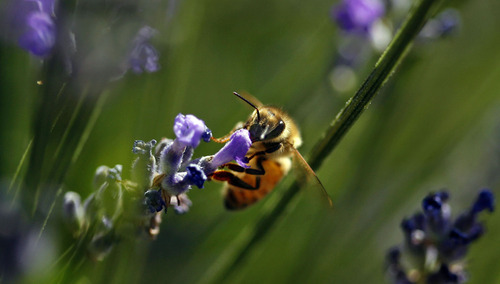This is an archived article that was published on sltrib.com in 2011, and information in the article may be outdated. It is provided only for personal research purposes and may not be reprinted.
It's not too late to join a nationwide volunteer effort to count bees on Saturday.
More than 400 Utahns, including 66 residents in Salt Lake City, are expected to be involved. They are among 100,000 citizen scientists committed to the San Francisco State University-based project to collect unprecedented data on wild bee pollinations.
Participants are asked to spot bees on flowers planted on balconies and community gardens in order to observe how many bees they see during two 15-minute observations on Saturday, or each month throughout the summer. They then report their data on a website, http://www.greatsunflower.org.
Although sunflowers are preferred, volunteers many use other plants in the bee count, including bee balm, cosmos, rosemary, tickseed and purple coneflower. And if you don't have access to these plants, just about any flower will do — as long as you report the name of the plant you're using in the count, said Elaine Bible, spokeswoman for the project.
Participants don't have to report the kinds of bees they are seeing on their plants, but that kind of data can be useful.
"For those who can distinguish a honey or a bumble or a carpenter bee, that can help us ask whether we are seeing more pollination coming from bees other than honey bees, or whether we're seeing a decrease in the service overall," lead researcher,Gretchen LeBuhn, said in a statement.
In the past four years of the project, volunteer gardeners reported seeing a bee pollinate plants every 2.6 minutes — although more than 20 percent of the participants never saw a single bee.
Nationwide, honeybees are being killed off by urbanization, mites, assorted viruses and now a mysterious ailment called colony collapse disorder. The latter phenomenon occurs when worker bees abruptly disappear.
In Utah, the number of bees also has been declining, in part because of loss of habitat. Utah has lost enough farm and grazing land during the past 40 years to exceed the acreage of Delaware and Rhode Island combined, according to the Utah Department of Agriculture and Food.
Honey bees may grab the headlines, but there are 4,000 species of bee in the United States — about a third of which live in California.
"When we talk about pollination, we're talking about 3,999 other species that also make these contributions," said LeBuhn an associate professor of biology. "I'd like to leave people with a sense of wonder that there's this big group of insects out there working for us."
Twitter: @DawnHouseTrib —
Volunteers needed for bee count
For more information on joining the Great Sunflower Project, visit http://www.greatsunflower.org, or follow the project on Twitter@GreatSunflower. Beehive State losing its namesake
• Current: 28,000 colonies, 988,000 pounds honey produced.
• Worst year: 2001; 23,000 colonies, 874,000 pounds honey.
• Record: 1963; est. 52,000 colonies, 4.3 million pounds honey.
Source: Utah Department of Agriculture and Food





